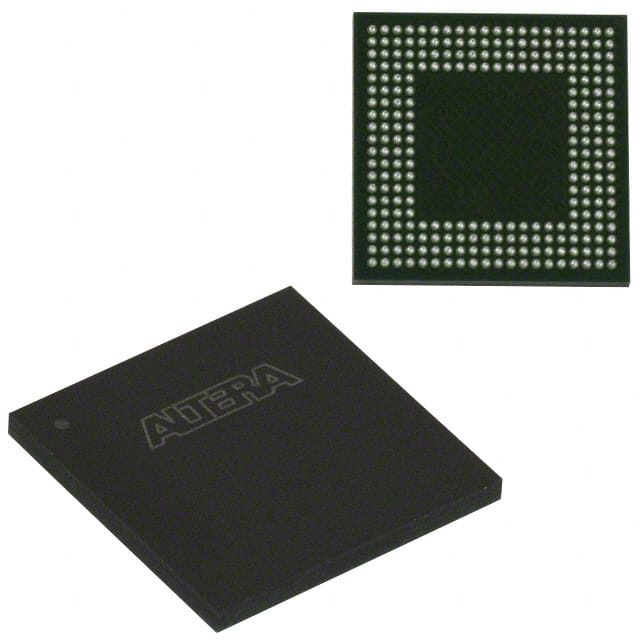Voir les spécifications pour les détails du produit.

EPF6016BC256-3
Product Overview
Category: Programmable Logic Device (PLD)
Use: The EPF6016BC256-3 is a PLD that offers high-performance logic integration and flexibility for various digital circuit applications.
Characteristics: - High-density programmable logic device - 16,000 usable gates - 256 macrocells - 3.3V operation - Advanced CMOS technology - Low power consumption - Fast propagation delay
Package: The EPF6016BC256-3 is available in a 256-ball FineLine BGA package.
Essence: This PLD provides designers with the ability to implement complex digital circuits efficiently and effectively.
Packaging/Quantity: The EPF6016BC256-3 is typically sold individually or in reels of multiple units.
Specifications
- Maximum Gates: 16,000
- Macrocells: 256
- Operating Voltage: 3.3V
- Package Type: 256-ball FineLine BGA
- Propagation Delay: <10 ns
- I/O Pins: 144
- JTAG Boundary Scan Support: Yes
- User Flash Memory: 1,000 bits
Detailed Pin Configuration
The EPF6016BC256-3 has a total of 144 I/O pins, which are organized into various groups based on their functionality. The pin configuration is as follows:
- Group A: Pins 1-20
- Group B: Pins 21-40
- Group C: Pins 41-60
- ...
- Group N: Pins 121-144
For a detailed pin configuration diagram, please refer to the datasheet provided by the manufacturer.
Functional Features
- High-density integration: The EPF6016BC256-3 offers a large number of usable gates and macrocells, allowing for the implementation of complex digital circuits.
- Flexibility: The device can be programmed and reprogrammed to meet changing design requirements.
- Low power consumption: The advanced CMOS technology used in this PLD ensures efficient power usage.
- Fast propagation delay: The EPF6016BC256-3 provides quick signal propagation, enabling high-speed operation.
Advantages and Disadvantages
Advantages: - High-density integration - Flexibility in design - Low power consumption - Fast propagation delay
Disadvantages: - Limited user flash memory (1,000 bits) - Requires specialized programming tools for configuration
Working Principles
The EPF6016BC256-3 is based on programmable logic technology. It consists of a matrix of configurable logic blocks (CLBs) interconnected by programmable interconnects. These CLBs can be configured to perform various logic functions, allowing designers to create custom digital circuits.
The device is programmed using a hardware description language (HDL) or a schematic entry tool. Once programmed, the EPF6016BC256-3 operates according to the specified logic functions.
Detailed Application Field Plans
The EPF6016BC256-3 is widely used in various applications, including but not limited to: - Digital signal processing - Communication systems - Industrial automation - Consumer electronics - Automotive electronics
Its high-density integration, flexibility, and fast propagation delay make it suitable for complex digital circuit designs in these fields.
Detailed and Complete Alternative Models
- EPF10K10ATC144-3: 10,000 usable gates, 144 macrocells, 3.3V operation, 144-pin TQFP package.
- EPF20K400CB652-2: 400,000 usable gates, 652 macrocells, 2.5V operation, 652-ball FineLine BGA package.
- EPF8452ATC100-4: 84,000 usable gates, 100 macrocells, 4.5V operation, 100-pin TQFP package.
These alternative models offer different gate counts, macrocell counts, operating voltages, and package options to cater to various design requirements.
Note: The above information is based on the specifications provided by the manufacturer. Please refer to the datasheet for the most accurate and up-to-date details.
Énumérez 10 questions et réponses courantes liées à l'application de EPF6016BC256-3 dans les solutions techniques
Sure! Here are 10 common questions and answers related to the application of EPF6016BC256-3 in technical solutions:
Q: What is EPF6016BC256-3? A: EPF6016BC256-3 is a specific model of Field Programmable Gate Array (FPGA) manufactured by Altera.
Q: What is the purpose of EPF6016BC256-3 in technical solutions? A: EPF6016BC256-3 is used as a programmable logic device that can be configured to perform various functions in electronic systems.
Q: What are the key features of EPF6016BC256-3? A: Some key features include 16,000 logic elements, 256-pin BGA package, 3.3V power supply, and 256 user I/O pins.
Q: How is EPF6016BC256-3 programmed? A: EPF6016BC256-3 can be programmed using Hardware Description Languages (HDLs) such as VHDL or Verilog.
Q: What are the typical applications of EPF6016BC256-3? A: EPF6016BC256-3 is commonly used in applications like digital signal processing, communication systems, industrial automation, and embedded systems.
Q: Can EPF6016BC256-3 be reprogrammed after initial configuration? A: Yes, EPF6016BC256-3 is a reprogrammable FPGA, allowing for flexibility in design changes or updates.
Q: What is the maximum operating frequency of EPF6016BC256-3? A: The maximum operating frequency of EPF6016BC256-3 depends on the specific design and implementation, but it can typically reach several hundred megahertz.
Q: Are there any development tools available for programming EPF6016BC256-3? A: Yes, Altera provides Quartus Prime software, which is commonly used for designing, simulating, and programming EPF6016BC256-3.
Q: Can EPF6016BC256-3 interface with other components or devices? A: Yes, EPF6016BC256-3 has multiple I/O pins that can be used to interface with other components or devices in a system.
Q: What are the advantages of using EPF6016BC256-3 in technical solutions? A: Some advantages include high flexibility, reprogrammability, fast prototyping, low power consumption, and the ability to implement complex logic functions in a single device.
Please note that these answers are general and may vary depending on specific design requirements and applications.

